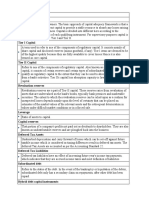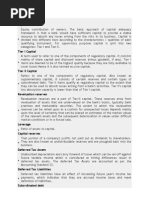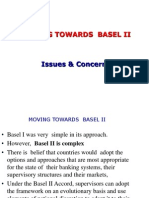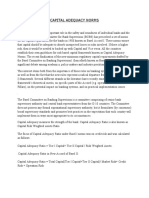Basel II Norms: Sunday, March 02, 2014
Basel II Norms: Sunday, March 02, 2014
Uploaded by
Amit Kumar JhaCopyright:
Available Formats
Basel II Norms: Sunday, March 02, 2014
Basel II Norms: Sunday, March 02, 2014
Uploaded by
Amit Kumar JhaOriginal Description:
Original Title
Copyright
Available Formats
Share this document
Did you find this document useful?
Is this content inappropriate?
Copyright:
Available Formats
Basel II Norms: Sunday, March 02, 2014
Basel II Norms: Sunday, March 02, 2014
Uploaded by
Amit Kumar JhaCopyright:
Available Formats
Presented By :
Ameya lakhe
Amit Kumar
Ashish Jha
Jagdish Agarwal
Basel II Norms
Sunday, March 02, 2014
2
Agenda
Introduction
Basel II-Framework
Pillar 1 Minimum Capital Adequacy
Pillar 2- Supervisory
Pillar 3- Market Discipline
Conclusion
Aim- to create an international standard for banking
regulators to control how much capital banks need to
put aside to guard against the types of financial and
operational risks banks face
How- by setting up rigorous risk and capital
management requirements to ensure that a bank
holds capital reserves appropriate to the risk the bank
exposes itself to through lending and investment
practices.
Greater the risk greater the amount of capital bank
needs to hold to safeguard its solvency and overall
economic stability.
Introduction
Shortcomings of Basel I
Capital required did not mirror a banks true risk profile
Too simple for advanced banks
Inflexible against new developments
Covers only credit and market risks
Only quantitative in nature
Limited recognition of collateral
Basel I
Basel I
Pillar 1:
Minimum capital
requirements
Risk-weighted
Assets
(Denominator)
Definition of
Capital
(Numerator)
Credit Risk
(1988)
Market Risk
(1996)
Greater emphasis on banks own assessment of risk
Comprehensive framework for credit, market and
operational risk
Encourages rigorous bank supervision
Ensures market transparency, disclosure
More risk sensitive; better align regulatory capital with
actual risk exposure
Objectives of Basel II
Three Pillars of Basel II
Pillar 1 sets out the minimum capital requirements firms will be
required to meet to cover credit, market and operational risk.
Pillar 2 sets out a new supervisory review process. Requires
financial institutions to have their own internal processes to
assess their overall capital adequacy in relation to their risk
profile.
Pillar 3 cements Pillars 1 and 2 and is designed to improve
market discipline by requiring firms to publish certain details of
their risks, capital and risk management as to how senior
management and the Board assess and will manage the
institution's risks.
The Basel II Framework
Three Pillars
Minimum
capital
requireme
nts
Risk
weighted
assets
Credit risk
Standardiz
ed
Internal
Ratings-
based
Operational
risk
Basic
Indicator
Standardiz
ed
Advanced
Measurem
ent
Market
risks
Standardiz
ed
Models
Definition
of
capital
Core
Capital
Suppleme
ntary
Capital
Supervisor
y review
process
Market
discipline
A measure of adequacy of an entitys capital resources in
relation to its current liabilities and also in relation to risk
associated with its assets.
An appropriate level of capital adequacy ensures that the
entity has sufficient capital to support its activities and its net
worth is sufficient to absorb adverse changes in the value of
its assets without becoming insolvent e.g. Banks are required
to maintain a certain level of capital against their (risk
adjusted) assets.
Banks are required to maintain a minimum CRAR of 9% on an
ongoing basis with Tier 1 CRAR of minimum 6%.
Risks weights assigned based on the different assets types
and obligors (higher for commercial real estate, equity/capital
market exposure, consumer credit)
Capital Adequacy
Total Capital=Tier 1 capital + Tier 2 capital less following deduction
adjustments
equity investments in subsidiaries;
shareholdings in other banks that exceed 10% of that bank's capital;
unrealized revaluation losses on securities holdings
Total risk-weighted assets are determined by:
multiplying the capital requirements for market risk and operational risk
by 12.5 and adding the resulting figures to the sum of risk-weighted
assets for credit risk.
Pillar 1: Minimum Capital Requirements
Capital Funds
Capital Funds to include both Tier I and Tier II Capital Funds
Tier I Capital
Paid Up Capital, Statutory Reserves, and other disclosed Free Reserves.
Capital Reserve
Innovative perpetual debt instruments subject to compliance with certain regulatory
requirements
Perpetual non cumulative Preference Shares subject to compliance with certain
regulatory requirements
Any other Instrument notified by RBI from time to time.
Tier II Capital
Revaluation Reserve (at discount of 55 percent)
General Provision and Loss Reserves
Hybrid Debt Capital Instruments
Subordinated Debt
Debt instruments, Perpetual Cumulative Preference Shares, Redeemable Non
Cumulative preference shares, redeemable cumulative preference shares.
Tier I Capital should at no point of time be less than 50% of the total capital. This
implies that Tier II cannot be more than 50% of the total capital.
Credit Risk
Previous norms prescribed single credit risk factor across a class of
obligors thus ignoring the default probability or risk rating of different
obligors. This results in assigning same amount of capital for exposures
to AAA rated and BB rated corporate.
Three approaches for computing RWAs for Credit Risk:
Standardized Approach: Risk Weights linked to external ratings of obligors
and tenor of the loan. Range between 0% to 150%. Unrated exposures to
be assigned 100% risk weight.
Foundational Internal Rating Approach: Risk Weights assigned on the basis
of obligors PD (Probability of Default).
Advanced Internal Rating Approach: Banks to use internal rating model for
key statistical data: credit ratings (probability of default or PD), Loss given
Default (LGD) and Exposure at default (EAD). Road map for migrating to
these approaches is issued.
To start with RBI has asked all banks to follow Standardized approach
and use external ratings assigned by any of the RBI approved local and
international rating agencies.
In determining the risk weights in the standardised
approach, banks may use assessments by external
credit assessment institutions.
Risk Weights linked to external ratings of obligors and
tenor of the loan.
Unrated exposures to be assigned 100% risk weight
Credit Risk - Standardised Approach
( )
Assets of Valus Book Assets for t Risk Weigh
In the internal ratings-based(IRB) approach, its based on
banks internal assessment.
The approach combines the quantitative inputs provides by
banks and formula specified by the Committee.
Four quantitative inputs (risk components):
Credit Risk - IRB Approach
Data Input
Foundation IRB
Advanced IRB
Probability of default
(PD)
From banks
From banks
Loss given default
(LGD)
Set by the
Committee
From banks
Exposure at default
(EAD)
Set by the
Committee
From banks
Maturity (M)
Set by the
Committee or from
banks
From banks
Credit Risk Capital Requirement
Credit Risk Probability of Default
Standardised method
the standards of the Committee
Internal models
use banks internal assessments
Value at Risk (VaR)
The value at risk is $1 million means that the bank is
99% confident that there will not be a loss greater than
$1 million over given time period.
Market Risk
The risk of losses results from inadequate or failed internal
processes, people and system, or external events.
It defines three approaches for this calculation:
Basic Indicator Approach: Capital Charge computed at 15%
of Gross Income of the Bank.
Standardized Approach: Capital Charge ranges between 12-
18% of gross income of different business lines.
Advanced Measurement Approach: Banks to use internal
model for computing potential operational loss.
To start with RBI has asked all banks to apply the Basic
Indicator Approach. Basic Indicator Approach is required to be
implemented by all banks operating in India. Roadmap for
Advanced approaches is prescribed by RBI.
Operational Risk
Basic Indicator Approach
GI = average annual gross income(three years, excepted the negative amounts)
= 15%
Standardised Approach
GI
1-8
= average annual gross income from business line from one to eight (three years,
excepted the negative amounts)
= A fixed percentage set by the Committee. ; 12% < < 18%
Advanced Measurement Approaches
Under the AMA, the regulatory capital requirement will equal the risk measure
generated by the banks internal operational risk measurement system using the
quantitative and qualitative criteria for the AMA.
Use of the AMA is subject to supervisory approval
Operational Risk Calculation
o =GI KBIA
( )
8 1 = | 8 1 GI KTSA
Beta of Business Lines
Business Lines
Beta Factors
Corporate finance (1)
18%
Trading and sales (2)
18%
Retail banking (3)
12%
Commercial banking (4)
15%
Payment and settlement (5)
18%
Agency services (6)
15%
Asset management (7)
12%
Retail brokerage (8)
12%
Principle 1: Banks should have a process for
assessing and maintaining their overall capital
adequacy.
Principle 2: Supervisors should review and evaluate
banks internal capital adequacy assessments and
strategies.
Principle 3: Supervisors should expect banks to
operate above the minimum regulatory capital ratios.
Principle 4: Supervisors should intervene at an early
stage to prevent capital from falling below the
minimum levels.
Pillar 2: Supervisory Review
The purpose of pillar three is to complement the pillar
one and pillar two.
Develop a set of disclosure requirements to allow
market participants to assess information about a
banks risk profile and level of capitalization.
Pillar 3: Market Discipline
Basel II - a more risk sensitive framework
Increased reliance on internal risk management
systems for regulatory capital
requires supervisory oversight (Pillar 2)
better disclosure of banks risk profile (Pillar 3)
Regardless of which Basel II approaches to adopt,
banks should continue to enhance their risk
management systems and practices
Conclusion
23
Thank you
You might also like
- EY Valuation Report 2021Document3 pagesEY Valuation Report 2021zach thomasNo ratings yet
- Ultimate Guide To Debt & Leveraged Finance - Wall Street PrepDocument18 pagesUltimate Guide To Debt & Leveraged Finance - Wall Street PrepPearson SunigaNo ratings yet
- Risk Management and Basel II: Bank Alfalah LimitedDocument72 pagesRisk Management and Basel II: Bank Alfalah LimitedtanhaitanhaNo ratings yet
- Tender DocumentDocument317 pagesTender Documentexecutive engineerNo ratings yet
- The Complete Financial Analyst TrainingDocument5 pagesThe Complete Financial Analyst TrainingAMONPTAH MA'ATNo ratings yet
- Evp6610005304464 - 2020 04 01 - 2020 04 20Document1 pageEvp6610005304464 - 2020 04 01 - 2020 04 20Pritom NasirNo ratings yet
- Basel PDFDocument24 pagesBasel PDFGaurav0% (1)
- Basel Norms Ii & Risk Management: Rasleen Kaur Sakshi Goenka Abhishek PassiDocument19 pagesBasel Norms Ii & Risk Management: Rasleen Kaur Sakshi Goenka Abhishek PassiTamanna KhemaniNo ratings yet
- Bank RiskPrudential NormsDocument35 pagesBank RiskPrudential Normsdivanshu aroraNo ratings yet
- Risk Management: Capital Management & Profit PlanningDocument25 pagesRisk Management: Capital Management & Profit Planningharry2learnNo ratings yet
- BASLE II A Simplified ExplanationDocument5 pagesBASLE II A Simplified ExplanationmanaskaushikNo ratings yet
- BaselDocument21 pagesBaseldev367No ratings yet
- Glossary: Capital Earnings Funds and Investment Asset Securitisation Nds-Om Web HomeDocument16 pagesGlossary: Capital Earnings Funds and Investment Asset Securitisation Nds-Om Web HomeSanjeet MohantyNo ratings yet
- Capital Capital FundsDocument10 pagesCapital Capital Fundsbhau_20No ratings yet
- Capital Adequacy and Profit Planning. Module DDocument47 pagesCapital Adequacy and Profit Planning. Module Dparthasarathi_inNo ratings yet
- Risk Management and Basel II: Bank Alfalah LimitedDocument72 pagesRisk Management and Basel II: Bank Alfalah LimitedCarl RodriguezNo ratings yet
- Glossary PDFDocument8 pagesGlossary PDFkumarsanjeev.net9511No ratings yet
- Capital Capital FundsDocument12 pagesCapital Capital FundsDrKhalid A ChishtyNo ratings yet
- Capital Capital FundsDocument11 pagesCapital Capital FundsSantosh Kumar BarikNo ratings yet
- Economics Glossary PDFDocument9 pagesEconomics Glossary PDFSK PNo ratings yet
- Risk Management: Presentation OnDocument41 pagesRisk Management: Presentation Onvandana005No ratings yet
- Basel IIDocument5 pagesBasel IIcozycapNo ratings yet
- Capital Earnings Funds and Investment Asset Securitisation HomeDocument7 pagesCapital Earnings Funds and Investment Asset Securitisation HomeKumar PsnNo ratings yet
- Basel NormsDocument33 pagesBasel NormsPaavni SharmaNo ratings yet
- International Convergence of Capital Measurement & Capital StandardsDocument57 pagesInternational Convergence of Capital Measurement & Capital StandardsDaniel VincentNo ratings yet
- Risk Based Capital Management For Banks: Janata Bank Staff College DhakaDocument39 pagesRisk Based Capital Management For Banks: Janata Bank Staff College DhakaUdita GopalkrishnaNo ratings yet
- FRM Cia 1Document10 pagesFRM Cia 1Gaurav MehtaNo ratings yet
- Risk Management & Basel IIIDocument31 pagesRisk Management & Basel IIIsatishNo ratings yet
- Risk Management in Banks and Basel - II ComplianceDocument35 pagesRisk Management in Banks and Basel - II ComplianceSrinivas AcharNo ratings yet
- UNIT IV Banking Theory Law and PracticeDocument8 pagesUNIT IV Banking Theory Law and PracticeLoganathan KrishnasamyNo ratings yet
- Components of Assets & Liabilities in Bank'S Balance SheetDocument7 pagesComponents of Assets & Liabilities in Bank'S Balance SheetAnonymous nx6TUjNP4No ratings yet
- Base 2Document20 pagesBase 2asifanisNo ratings yet
- Basel II and Risk MGMTDocument6 pagesBasel II and Risk MGMTSagar ShahNo ratings yet
- Risk Management Framework: by Prof Santosh KumarDocument30 pagesRisk Management Framework: by Prof Santosh KumarAYUSH RAVINo ratings yet
- Basel ReportDocument8 pagesBasel ReportskenkanNo ratings yet
- Banking Regulatory Environment: Basel GuidelinesDocument7 pagesBanking Regulatory Environment: Basel GuidelinesNidhi Modi KariaNo ratings yet
- B III I B S: Asel AND ITS Impact ON THE Ndian Anking EctorDocument24 pagesB III I B S: Asel AND ITS Impact ON THE Ndian Anking EctorMahesh Prasad PandeyNo ratings yet
- Moving Towards Basel Ii: Issues & ConcernsDocument36 pagesMoving Towards Basel Ii: Issues & Concernstejasdhanu786No ratings yet
- Finance Notes For RBI Grade B - Phase 2Document106 pagesFinance Notes For RBI Grade B - Phase 2abinash67% (3)
- Basel 4Document7 pagesBasel 4Raj shekhar PandeyNo ratings yet
- Risk Management: Presentation OnDocument41 pagesRisk Management: Presentation OnAbhishek KarekarNo ratings yet
- Importance of Basel 1 & 2Document25 pagesImportance of Basel 1 & 2anand_lamani880% (1)
- Risk Management: Basel Committee On Banking Supervision (BCBS)Document25 pagesRisk Management: Basel Committee On Banking Supervision (BCBS)Shirsendu Bikash DasNo ratings yet
- The New Framework Has Three Mutually: 1 - The Minimum Capital RequirementsDocument2 pagesThe New Framework Has Three Mutually: 1 - The Minimum Capital RequirementsMohamed Awny El NagarNo ratings yet
- Capital Adequacy in Indian Banks 3Document43 pagesCapital Adequacy in Indian Banks 3arshita sharmaNo ratings yet
- Basel II - A New Global Banking Paradigm: Bharat S Raut & CoDocument12 pagesBasel II - A New Global Banking Paradigm: Bharat S Raut & CoJivaansha SinhaNo ratings yet
- RAROCDocument22 pagesRAROCchelsea1989No ratings yet
- Commercial Banking Assignment: Dhruti Bhatia Roll No: 062 Specialization-Finance MMS - 2020Document8 pagesCommercial Banking Assignment: Dhruti Bhatia Roll No: 062 Specialization-Finance MMS - 2020Dhruti BhatiaNo ratings yet
- Basel 2 NormsDocument11 pagesBasel 2 NormsAbhishek RajputNo ratings yet
- Insights - A Journey From Basel II To Basel IVDocument12 pagesInsights - A Journey From Basel II To Basel IV0399shubhankarNo ratings yet
- Basel 3Document3 pagesBasel 3NITIN PATHAKNo ratings yet
- (Bank Policy) BASELDocument30 pages(Bank Policy) BASELprachiz1No ratings yet
- Basel III Basel IV Norms For Resilient Banking System 1696102664Document10 pagesBasel III Basel IV Norms For Resilient Banking System 1696102664suman.sarkar55No ratings yet
- 10 Capital Adequacy NormsDocument23 pages10 Capital Adequacy NormsBindal HeenaNo ratings yet
- Op Risk RulesDocument14 pagesOp Risk Rulesapi-3807149No ratings yet
- Capital Adequacy NormsDocument13 pagesCapital Adequacy NormsicdawarNo ratings yet
- Basel 1and 2 NewDocument28 pagesBasel 1and 2 NewnipuntrikhaNo ratings yet
- Basel NormsDocument19 pagesBasel NormsJoelNo ratings yet
- Risk FrameworkDocument28 pagesRisk FrameworkshilpeeNo ratings yet
- Methods of Quantifying Operational Risk in Banks: Theoretical ApproachesDocument7 pagesMethods of Quantifying Operational Risk in Banks: Theoretical ApproachesAJER JOURNALNo ratings yet
- The Basel Ii "Use Test" - a Retail Credit Approach: Developing and Implementing Effective Retail Credit Risk Strategies Using Basel IiFrom EverandThe Basel Ii "Use Test" - a Retail Credit Approach: Developing and Implementing Effective Retail Credit Risk Strategies Using Basel IiNo ratings yet
- Financial Services Firms: Governance, Regulations, Valuations, Mergers, and AcquisitionsFrom EverandFinancial Services Firms: Governance, Regulations, Valuations, Mergers, and AcquisitionsNo ratings yet
- Managing Credit Risk: The Great Challenge for Global Financial MarketsFrom EverandManaging Credit Risk: The Great Challenge for Global Financial MarketsNo ratings yet
- General Math Las and Lectures 2nd QuarterDocument21 pagesGeneral Math Las and Lectures 2nd QuarterPaul Vincent JimenezNo ratings yet
- EXIM Finance Unit IIDocument11 pagesEXIM Finance Unit IIloganathanNo ratings yet
- Classified Ad Scams: How This Scam WorksDocument3 pagesClassified Ad Scams: How This Scam WorksRichardNo ratings yet
- QUALIFYING EXAM TOS - 2nd Year - 2021Document8 pagesQUALIFYING EXAM TOS - 2nd Year - 2021christ maryNo ratings yet
- CH 9Document82 pagesCH 9Michael Fine100% (2)
- Guidelines For Conducting Revenue Audit of PSPCLDocument48 pagesGuidelines For Conducting Revenue Audit of PSPCLsahil rohitNo ratings yet
- Accountancy GoodwillDocument5 pagesAccountancy GoodwillPrachi SanklechaNo ratings yet
- Research Proposal FinalDocument21 pagesResearch Proposal FinalYohannes Alemu100% (1)
- Bank ABC Islamic Announces 21% Increase in First Half 2019 Net Profit To US$18.9 MillionDocument1 pageBank ABC Islamic Announces 21% Increase in First Half 2019 Net Profit To US$18.9 MillionasdsadsasadsaNo ratings yet
- Acct Statement - XX2389 - 08012024Document22 pagesAcct Statement - XX2389 - 08012024patelvlogs94No ratings yet
- Final ExamDocument2 pagesFinal Exampauline faye bayaniNo ratings yet
- g1967 E PDFDocument769 pagesg1967 E PDFJAMF JFNo ratings yet
- Impairment of Loans and Receivable FinancingDocument17 pagesImpairment of Loans and Receivable FinancingGelyn CruzNo ratings yet
- Chapter 4 F7Document47 pagesChapter 4 F7Kelvin MasekoNo ratings yet
- Ratio Analysis of Over The Last 5 Years: Power Grid Corporation of India LTDDocument10 pagesRatio Analysis of Over The Last 5 Years: Power Grid Corporation of India LTDShubham DikshitNo ratings yet
- Bank TransferDocument1 pageBank TransferFareed KhanNo ratings yet
- Organisational Study SampleDocument90 pagesOrganisational Study SampleAbishek KSNo ratings yet
- AzureDocument5 pagesAzuresudhanshuNo ratings yet
- Moodys Analytics Riskcalc Transfer Pricing SolutionDocument9 pagesMoodys Analytics Riskcalc Transfer Pricing SolutionManuel CámacNo ratings yet
- Notable Us Error CoinDocument34 pagesNotable Us Error Coinnexlance001No ratings yet
- Standing OrderDocument1 pageStanding Orderapi-437315390No ratings yet
- ACCT 5103 OL Sample Final ExamDocument7 pagesACCT 5103 OL Sample Final ExamEsther MpyisiNo ratings yet
- Accounts Set B 2022 2023 Class 11Document2 pagesAccounts Set B 2022 2023 Class 11Satyam SoniNo ratings yet
- Introduction To Money Payment System-2Document42 pagesIntroduction To Money Payment System-2lawwrrance chanNo ratings yet
- Private Placement PlatformDocument36 pagesPrivate Placement Platformutopianzhere100% (1)

























































































